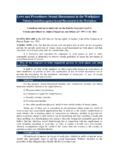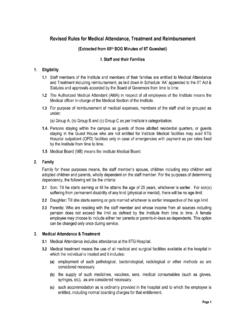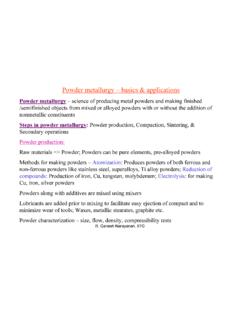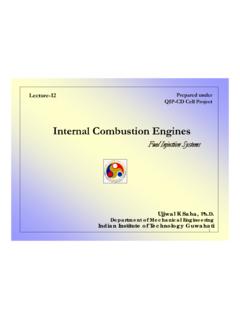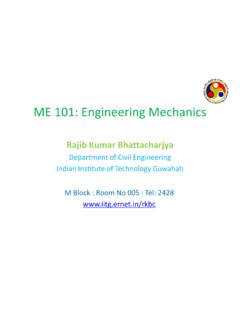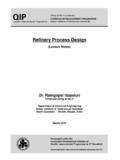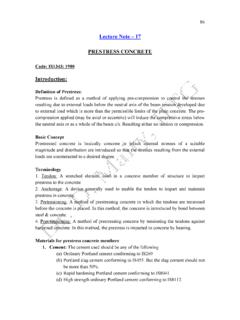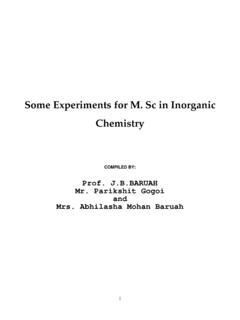Transcription of CE 311: Hydrology & Water Resources Engineering
1 CE 311: Hydrology & Water Resources EngineeringProf. (Dr.) Rajib Kumar BhattacharjyaIndian Institute of Technology GuwahatiGuwahati, AssamEmail: :Surface Water Hydrology -hydrologic cycle, rainfall and its measurement, mean rainfall, runoff; Flow measurements; Infiltration losses; Storm Hydrology ; Unit Hydrograph; Storm hydrograph; Reservoir planning -Investigations, life of reservoir; Flood estimation and routing, flood forecasting; Surface and sub-surface drainage, Water logging, remedial measures, drainage of land; Ground Water Hydrology -Introduction, types of aquifers, wells, well yield; Soil- Water -Plant relationships, crop Water requirement; Layout of canal system; Types and methods of 311: Hydrology & Water Resources Engineering (3-0-0)Course objectives: To develop technical skills for modelling and quantifying hydrological processes.
2 Development of research capabilities so that the students completing the course shall be capable of pursuing further works on Water management, integrated Water Resources management, urban Water management, flood control, managing climate change impacts on the Water cycle, canal design, etc. Expected outcome: The students shall be able to formulate hydrological processes in mathematical terms; be able to work with and recognize the limitations of hydrological data; be able to employ mathematical and computational techniques to solve real life hydrological : Chow, Maidment, and Mays, Applied Hydrology , McGraw Hill, 1998. Singh, Elementary Hydrology , Prentice Hall, 1993. References: Raghunath, Hydrology Principles, Analysis and Design, Wiley Eastern Ltd.
3 , 1986. Michael, Irrigation Theory and Practice, VikasPublishing House, 1987. Todd, Groundwater Hydrology , John Wiley & Sons, 1993. K. Linsley, Water Resources Engineering , McGraw Hill, 1995. Garg, Irrigation Engineering and Hydraulic Structures, Khanna Publishers, 1992. Ritzema(Editor-in-Chief), Drainage Principles and Applications, ILRI Publication 16, and reference booksNPTEL course on Groundwater HydrologyAssessment Assignment: 15 Quiz: 15 Mid semester exam: 30 End semester exam: 401/17/20174 Hydrology is the science that treats the waters of the earth, their occurrence, circulation and distribution, their chemical and physical properties, and their reaction with their environment, including their relation to living things. The domain of Hydrology embraces the full life history of Water on the earth Assessment: availability of waterWater use : Water withdrawal and instream usesWater Control : flood and drought mitigationPollution Control : point and nonpoint sourcesHydrologyWhat hydrologists do:HOMER (800 BC) It was thought that the land mass floated on a body of Water , and the Water in rivers and lakes has its origin under the earth.
4 Examples of this belief can be found in the works of timesAnaxagoras (460 BC)Theideathatthewatercycleisaclosedcycl ecanbefoundintheworksofAnaxagorasofClazo menae(460BC)andDiogenesofApollonia(460BC ).Plato (390 BC) and Aristotle (350 BC)PlatoandAristotlespeculatedaboutthepe rcolationofwaterthroughthegroundaspartof thewatercycleLeonardo Da Vinci (1500)UptothetimeoftheRenaissance(14thto the17thcentury),itwasthoughtthatprecipit ationalonewasnotsufficienttofeedrivers,f oracompletewatercycle, (1240AC),asdidLeonardodaVinci(1500AC)and AthanasiusKircher(1644AC).Bernard Palissy(1580) first told that rainfall alone is sufficient for the maintenance of rivers Natural entities and forces, such as Sun, Earth, Rivers, Ocean, Wind, Water , etc. have been worshipped in India as Gods since time immemorial.
5 Perhaps it is not a sheer coincidence that the King of these Gods is Indra, the God of Rain. This shows that the ancient Indians were aware of the importance of rain and other hydrologic variables for the society. The ancient Indian literature contains numerous references to Hydrology and a reading of it suggests that those people knew the basic concepts of hydrological processes and measurements. Important concepts of modern Hydrology are scattered in various verses of Vedas, Puranas, Meghmala, Mahabharat, Mayurchitraka, VrhatSanhitaand other ancient Indian in ancient IndiaHydrologic CycleHenry DarcyDaltonHortonGlobal distribution of Water Global Water balance (volumetric)Land ( km2)(29% of earth area)Ocean ( km2)(71% of earth area)Precipitation100 Evaporation61 Surface Outflow38 Subsurface Outflow1 Precipitation385 Evaporation424 Atmospheric moisture flow 39 Units are in volume per year relative to precipitation on land (119,000 km3/yr) which is 100 unitsGlobal Water balanceLand ( km2)(29% of earth area)Ocean ( km2)(71% of earth area)Precipitation800 mm (31 in)Evaporation480 mm (19 in)Outflow320 mm (12 in) Precipitation1270 mm (50 in)
6 Evaporation1400 mm (55 in)Atmospheric moisture flow 316 mm (12 in)Applied Hydrology , Table , (Values relative to land area)Residence TimeResidence time:Average travel time for Water to pass through a subsystem of the hydrologic cycle = (Storage/flow rate)Residence time of global atmospheric moistureVolume (storage) of atmospheric Water : 12,900 3 Flow rate of moisture from the atmosphere as precipitation = 577,000 km3/yr = 12,900/577,000 = yr= daysOne reason why weather cannot be forecast accurately more than a few days aheadChallenges before the countryRainfallThardesert:Averageannualr ainfallislessthan13cm, ,ontheotherhand,thenumberofrainydaysinRa jasthanisaround20daysSource: IMD, IndiaForest23%Agriculture44%Non Agriculture33%Rainfed60%Irrigation40%91% 2%7%AgricultureIndustrialMunicipalWATER USEAREA DISTRIBUTIONC hallenges before the countryRural IndiaAmount of renewable Water resourcesSurface Water : 1869 BCMG roundwater.
7 396 BCMP ressure on water1582 m3/yr/capitaAll TO TAP WATERAll PUMP/WELLAll SOURCE AWAY FROM HOMEAll ACCESS SANITATIONC hallenges before the countryAll TO ELECTRICITYAll LAMPAll IndiaRuralUrban1164584897760266824NO LIGHTC hallenges before the CAPITA Water AVAILABILITY(X1000 M3) 197520002025 Challenges before the countryChallenges before the country More than 26 cubic miles of groundwater disappeared from aquifers in areas of Haryana, Punjab, Rajasthan and the nation's capitol territory of Delhi, between 2002 and 2008. This is enough Water to fill Lake Mead, the largest manmade reservoir in the United States, three times. A study shows that the estimated rate of depletion of Water table in northwestern India is 33 centimeters per year1996200220062011 Challenges before the countryGroundwater scenario of the Golaghat, AssamChallenges before the Level (m)YearAverageMaximumMinimumWater level at Zoo Nagangi, Guwahati Depletion of average GL between 1996 and 2015 is m ( ft.)
8 Maximum depletion of GL between 1996 and 2015 is m ( ft.) Minimum depletion of GL between 1996 and 2015 is m ( ft.)Average depletion per year is cmThis is alarming! Groundwater scenario in GuwahatiRiver Linking ProjectElevation difference between two ends of the red line is around 2299 mPotential hydro-power project sites GREAT BEND Mega project with huge storage can store Water for longer period Installed capacity of 40,000 MW, almost double the Three gorge projectMEGA HYDRO ELECTRIC PROJECT AT GREAT BENDDams on YarlungTsangpoLOCATIONS of DAMSW ater Diversion Project of China Can divert 57 BCM waterSource: Liang, 2013 Water Diversion Project of China three ways to implement the project Only hydropower generation Divert Water during monsoon Divert Water throughout the yearSource.
9 Liang, 2013 DOWNSTREAM IMPACT ANALYSISRIVER MODLING AND MANAGEMENT SYSTEMS imulation- optimization based model to find obtain cost effective combination of river training worksApplied on River BrahmaputraImpact of climate change Climate change may have significant impact on flow of river Brahmaputra Monsoon flow of the river may increase by twenty percent in future Lean period flow may decrease by fifteen to twenty percent Number of dry day may increase in future Temperature increase by to degree Shifting of Monsoon Reduction in Himalayan glacier/snow cover Source: India s 1stcommunication to UNFCCI mpact of climate change Agriculture 10-40% loss in crop production in India India could lose 4-5 million tons wheat production with every degree rise temperature Up to 50% reduction in maize yields Rise in coconut yields Reduction in apple production Forest Net Primary Productivity is projected to increase by and under the A2 and B2 scenarios, respectively 39% of forest are likely to undergo vegetation type change under the A2 scenario and 34% under the B2 scenario Human health Higher mortality from heat stress and vector/ Water -borne diseases Expanded transmission window for malariaWater Energy Nexus and Virtual waterWater for energyEnergy for waterHydropowerThermo-electrical coolingBio fuel (Ethanol)
10 Extraction and transportation Municipal Water treatment Waste Water treatmentIrrigationWater Energy NexusWe use energy to reclaimed waterSourceEnergy (kWh/Mgal)Reclaimed water1514-3785 Toilet to tapWater Energy NexusQ. How much Water is needed to make a cup of tea?Q. How much Water is needed to make a cup of coffee?Ans. 27litreper cup for 250mlAns. 132litreper cup of 125 mlVirtual Water and its trade1 glass of Milk200L1 Apple70L1 Orange50L1 Potato25L1 Pizza1259L1 L of Bio-diesel ( soybean)11397L1 Kg of Rice2497L1 Kg Chocolate1259 LVirtual Water and its tradeCountryTea (MKG) Water (ML) Water (MCM)14-1513-1414-1513-1414-1513-14 Russian (ARE) ,52,59720,00,2341,7532,000 Virtual Water flow from India through tea industry is around 20 lakh million liters per yearFlow of virtual Water by the tea industryFlow of virtual Water by the tea industryRIVERMONITORINGSYSTEMR iver migration studyCenterline migration studyDelineation of FloodplainDetermination river widthDeyAveedibya, andBhattacharjya Rajib Kumar(2013)
